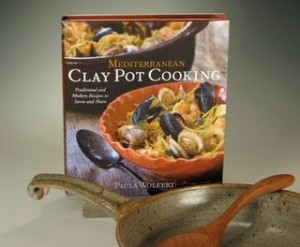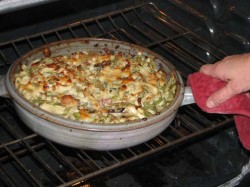In her fabulous book “Mediterranean Clay Pot Cooking,” Paula Wolfert provides some excellent guidance on the use of clay pots for cooking of both the wonderful Mediterranean recipes she provides, and the ability to adapt use of these pots to modern cooking.
 First and foremost, there are basically two types of clay pots used, earthenware based and stoneware based, determined by the clay bodies from which they’re made.
First and foremost, there are basically two types of clay pots used, earthenware based and stoneware based, determined by the clay bodies from which they’re made.
The more traditional type of pot is from clays dug in a relatively few areas of the world. These are considered earthenware based clays as they are generally fired to about 1950F (although in many cases much lower), but contain naturally combined mica and/or other ingredients which gives them the strength to withstand being heated over a gentle direct flame. The clay remains slightly or very porous and oftentimes is unglazed. If the interior is glazed, it is to make the pot waterproof from the inside. Always be gentle with these pots as they were originally intended for use over charcoal fires. A flame diffuser is generally advised on direct flames.
The second type of pottery which will withstand direct heat is more recently developed and is called ‘Flameware.” It is a combination of clays, silica, and a lithium ore (spodumene is usually used). It is high-fired (at least 2387 degF) and often higher. At these temperatures, the lithium undergoes a one-way expansion which later prevents the pot from undergoing the normal, silica-based expansion and contraction when a pot is heated and cooled.
Potters don’t use these flameware clay bodies for general stoneware work, since the spodumene dramatically affects the glaze color. Also, because the clay doesn’t have normal expansion, regular stoneware glazes can’t be used. These clay bodies are also more difficult to work with, becoming very soft in firing and requiring separate steps to ensure there aren’t hidden cracks. Because of all this, very few individual potters are willing to go through the development and testing of flameware pots. There are a few manufacturers such as Nigella Lawson and Emile Henri who have also done this successfully.
Regular stoneware pottery such as bowls and baking dishes will take oven heating because the heat surrounds the whole pot, causing it to expand all at one time. These stoneware pots will not take direct flame since that flame is heating only part of the pot, which tries to expand against the unheated part. Only Flameware will take the direct stovetop heat.

In Flameware ceramic stovetop pots, the clay doesn’t expand nearly as much as stoneware, so it will take direct flame, electric or glasstop stove heat. These pots are especially useful since they can go from stovetop to oven to table with no risk of damage.
I have seen online posts showing Flameware melting aluminum, being quenched from high temps. These are all things any true Flameware pot will do with ease.
Be sure any Flameware pot you buy is fully guaranteed. If you have any questions, please add them as a comment and I’ll tell you what we know. Coming posts will talk about using these new Flameware ceramic stovetop pots.
The question of using a flame spreader or diffuser comes up continually. First, since ceramic of any kind is an insulator, heat comes through where it’s applied, it doesn’t mover through the pot. Ceramic stovetops spread it the best, then gas and finally electric, where there is little spreading. So, if you keep the food moving, you won’t need a spreader. For gentle simmering over any heat source (where clay pots really shine) you probably won’t need one, but it doesn’t hurt to have one. A diffuser is a good idea over electric stovetops.
